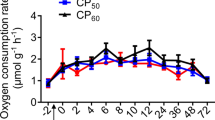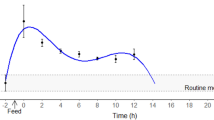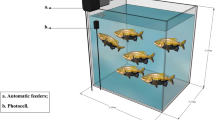Abstract
The present study was designed to evaluate the effect of a natural prey (the crab Callinectes sp.) and an artificial diet (pellet with squid paste and offered as a paste) on the survival and assimilation efficiency of subadult octopuses with 486 g of initial live weight. In order to reach this goal, the effects of the type of diet on energetic balance were assessed by recording ingestion rate (C), respiratory rate (R = R routine, Rrout + R apparent heat increment, RAHI), ammonia production rate (U = U routine, Urout + U post-prandial, UPP) and biomass production (P) of Octopus maya during its growing process. Energy lost from faeces (H) was calculated as H=C−(U+R+P) and assimilated energy (As) as R + P. Octopuses fed an artificial diet had almost five times higher ingestion rate compared to that observed in octopuses fed crab. However, growth rate and production (P) were high in octopuses fed crab in comparison to octopuses fed artificial diet. An inverse relation between faeces (H) and type of food was observed, indicating that animals lost 77% of the ingested energy when fed artificial diet and only 5% when fed crab. A higher assimilation and production efficiency were obtained in octopuses fed crab (P/As: 61%) than in animals fed the artificial diet (P/As: −5%). The routine O : N ratio for animals in fasting was 9.1 and 2.3 for octopuses being fed crabs and the artificial diet, respectively. The post-alimentary O : N ratio was 3.6 and 2.2 for animals fed crabs and the artificial diet, respectively. This indicates that animals fed on both diets rely almost exclusively on protein. Based on energy balance data, a value of 472 kJ week−1 kg−1 of live octopus was estimated as the energy needed to obtain a growth rate near 9 g day−1 (2.8% BW day−1) for O. maya subadults. The total crab biomass needed to obtain 1 kg of fed O. maya biomass was calculated. A comparison with other different energy balance measurements made in other octopus species indicates that O. maya and Enteroctopus megalocyathus (Pérez et al. 2006) tend to be more efficient by channelling more ingested energy to biomass production (P = 69.5% of C) than O. vulgaris (P = 23% of C; Petza et al. 2006) or Paraledone charcoti (P = 4% of C; Daly and Peck 2000).



Similar content being viewed by others
References
APHA (1995) Standard methods for the examination of water and wastewater, 19th edn. American Public Health Association
Beamish FWH, Trippel EA (1990) Heat increment: a static or dynamic dimension in bioenergetic models? Trans Am Fish Soc 119:649–661
Boucher-Rodoni R, Mangold K (1985) Ammonia excretion during feeding and starvation in Octopus vulgaris. Mar Biol 86:193–197
Castro B (1991) Can Sepia officinalis L. Be reared on artificial food? Mar Behav Physiol 19:35–38
Castro B, DiMarco FP, DeRusha R, Lee PG (1993) The effects of surimi and pelleted diets on the laboratory survival, growth and feeding rate of the cuttlefish Sepia officinalis. J Exp Mar Biol Ecol 170:241–252
Castro B, Lee PG (1994) The effects of semi-purified diets on growth and condition of Sepia officinalis L. (Mollusca: Cephalopoda). Comp Biochem Physiol 109A:1007–1016
Cerezo-Valverde J, Garcia-Garcia B (2005) Suitable dissolved oxygen levels for common octopus (Octopus vulgaris cuvier, 1797) at different weights and temperatures: analysis of respiratory behaviour. Aquaculture 244:303–314
Cerezo-Valverde J, García-García B (2004) Influence of body weight and temperature on post-prandial oxygen consumption of common octopus (Octopus vulgaris). Aquaculture 233:599–613
Daly HI, Peck LS (2000) Energy balance and cold adaptation in the octopus Paraledone charcoti. J Exp Mar Biol Ecol 245:197–214
DeRusha R, Forsythe JW, DiMarco FP, Hanlon RT (1989) Alternative diets for maintaining and rearing cephalopods in captivity. Lab Anim Sci 39(306):312
Domingues P (1999) Development of alternative diets for the mass culture of the European cuttlefish Sepia officinalis. University of the Algarve, Portugal, pp 1–95
Domingues P, DiMarco FP, Andrade JP, Lee PG (2005) Effect of artificial diets on growth, survival and condition of adult cuttlefish, Sepia officinalis Linnaeus, 1758. Aquacult Int 13:423–440
García-García B, Aguado-Giménez F (2002) Influence of diet on growing and nutrient utilization in the common octopus (Octopus vulgaris). Aquaculture 211:173–184
Hanlon RT, Forsythe W (1985) Advances in the laboratory culture of octopuses for biomedical research. Lab Anim Sci 35:33–40
Hanlon RT, Turk PE, Lee PG (1991) Squid and cuttlefish mariculture: an update perspective. J Ceph Biol 2:31–40
Katsanevakis S, Protopapas N, Miliou H, Verriopoulos G (2005) Effect of temperature on specific dynamic action in the common octopus Octopus vulgaris (Cephalopoda). Mar Biol 146:733–738
Lee PG (1994) Nutrition of cephalopods: fuelling the system. Mar Freshw Behav Physiol 25:35–51
Lee PG, Forsythe JW, DiMarco FP, DeRusha R, Hanlon RT (1991) Initial palatability and growth trials on pelleted diets for cephalopods. Bull mar Sci 49:362–372
Lucas A (1993) Bioénergétique Des Animaux Aquatiques. Masson, Paris
Mayzaud P, Conover RJ (1988) O:N atomic ratio as a tool to describe zooplankton metabolism. Mar Ecol Prog Ser 45:289–302
Miliou H, Fintikaki M, Kountouris T, Verriopoulos G (2005) Combined effects of temperature and body weight on growth and protein utilization of the common octopus Octopus vulgaris. Aquaculture 249:245–256
O’Dor RK, Mangold K, Boucher-Rodoni R, Wells MJ, Wells J (1983) Nutrient absorption, storage and remobilization in Octopus vulgaris. Mar Behav Physiol 11:239–258
Obaldo LG, Divakaran S, Tacon AG (2002) Method for determining the physical stability of shrimp feeds in water. Aquacult Res 33(5):369–377
Pérez MC, López DA, Aguila K, González ML (2006) Feeding and growth in captivity of the octopus Enteroctopus megalocyathus. Aquacult Res 37:550–555
Petza D, Katsanevakis S, Verriopoulos G (2006) Experimental evaluation of the energy balance in Octopus vulgaris, fed ad libitum on a high-lipid diet. Mar Biol 148:827–832
Romjin C (1935) Die Verdaunngsenzyme bei einigen Cephalopoden. Arch Neerl Zool 1:373–431
Rosas C, Bolongaro-Crevenna A, Sanchez A, Gaxiola G, Soto L, Escobar E (1995) Role of the digestive gland in the energetic metabolism of Penaeus setiferus. Biol Bull 189:168–174
Rosas C, Cuzon G, Gaxiola G, Pascual C, Taboada G, Arena L, VanWormhoudt A (2002) An energetic and conceptual model of the physiological role of dietary carbohydrates and salinity on Litopenaeus vannamei juveniles. J Exp Mar Biol Ecol 268:47–67
Rosas C, Sanchez A, Díaz E, Soto LA, Gaxiola G, Brito R (1996) Effect of dietary protein level on apparent heat increment and post-prandial nitrogen excretion of Penaeus setiferus, P. schmitti, P. duorarum and P. notialis postlarvae. J World Aquacult Soc 27:92–102
Rosas C, Vanegas C, Tabares I, Ramirez J (1993) Energy balance of Callinectes rathbunae Contreras 1930 in floating cages in a tropical coastal lagoon. J World Aquacult Soc 24:71–79
Segawa S, Hanlon RT (1988) Oxygen consumption and ammonia excretion rates in Octopus maya, Loligo forbesi and Lolliguncula brevis (Molluscs: Cephalopoda). Mar Behav Physiol 13:389–400
Solis M (1967) Aspectos biológicos del pulpo Octopus maya Voss y Solis. Inst Nacional Investig Biol Pesqueras (México) 18:1–90
Solis M (1997) The Octopus maya fishery of the Yucatán Peninsula. The fi shery and market potential of Octopus in California. CMSC 10:1–10
Solis M (1998) Aspectos biológicos del pulpo Octopus maya Voss y Solis. Contribuciones de investigación pesquera. Inst Nac de la Pesca 7:1–38
Takahashi T (1960) Biochemical studies on the viscera of cuttlefish, Omastrephes sloani pacificus. Bull Jpn Soc Sci Fish 26:500–507
Takahashi T (1963) Studies on the viscera enzymes of cuttlefish Omastrephes sloani pacificus. J Fac Fish Prefect Univ Mie 5:384–411
Van Heukelem WF (1976) Growth, bioenergetics and life span of Octopus cyanea and Octopus maya. University of Hawaii, Hawaii, pp 1–224
Van Heukelem WF (1977) Laboratory maintenance, breeding, rearing and biomedical research potential of the Yucatan octopus (Octopus maya). Lab Anim Sci 27:852–859
Van Heukelem WF (1983) Octopus maya. Cephalopod life cycles. Academic, London, pp 311–323
Villanueva R, Riba J, Ruíz-Capillas C, González AV, Baeta M (2004) Amino acid composition of early stages of cephalopods and effects of amino acid dietary treatmets on Octopus vulgaris paralarvae. Aquaculture 242:455–478
Wells MJ, O’Dor RK, Mangold K, Wells R (1983) Diurnal changes in activity and metabolic rate in Octopus vulgaris. Mar Behav Physiol 9:275–287
Acknowledgements
The present study was partially financed by DGAPA-UNAM project No: IN216006-3, and SAGARPA-CONACYT 2005-11720.
Author information
Authors and Affiliations
Corresponding author
Additional information
Communicated by P.W. Sammarco.
Rights and permissions
About this article
Cite this article
Rosas, C., Cuzon, G., Pascual, C. et al. Energy balance of Octopus maya fed crab or an artificial diet. Mar Biol 152, 371–381 (2007). https://doi.org/10.1007/s00227-007-0692-2
Received:
Accepted:
Published:
Issue Date:
DOI: https://doi.org/10.1007/s00227-007-0692-2




